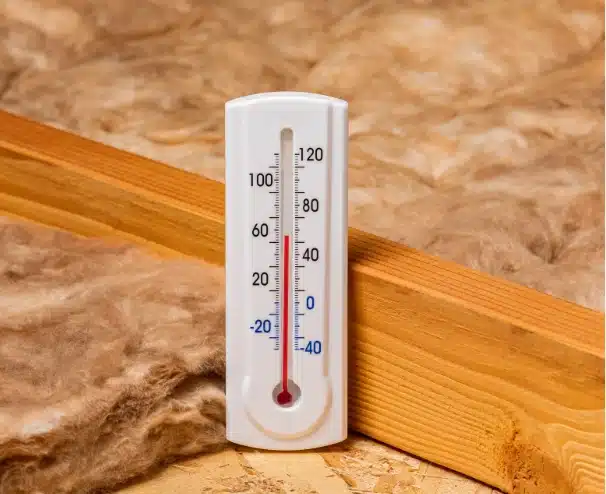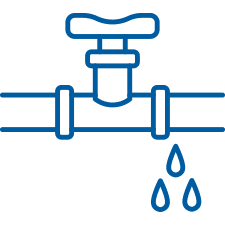Is Your Home Struggling to Stay Warm This Winter?
If your home feels chilly no matter how high you turn up the thermostat or if some rooms are toasty while others feel like an icebox your attic insulation might be to blame.
Imagine sitting in your living room and suddenly feeling a cold draft at your feet. Drafts like these can cause real discomfort, especially when the chill settles around your feet, making it hard to relax. Living in a cold, drafty home leads to ongoing discomfort for you and your family.
As snow starts to fall across Chicagoland, more homeowners are asking questions like:
- “Why is my home so cold in winter?”
- “Why are temperatures so inconsistent in my house?”
- “Why does my furnace never seem to shut off?”
At Perma-Seal, we know these are telltale signs of an attic that isn’t doing its job. The good news? Upgrading your insulation can make a dramatic difference in comfort, energy efficiency, and long-term home health. If you’ve noticed wall cracks or other potential foundation concerns in addition to attic issues, you may want to learn more about the cost of fixing a crack.
Here are the 7 biggest signs your attic insulation needs an upgrade—and what you can do about it.
1. Uneven Temperatures Throughout the House
If one room feels cozy while another is freezing, it’s likely due to uneven insulation coverage. As heat rises, warm air moves upward and, without proper attic insulation, escapes through the roof. The result? Your furnace works overtime to chase the cold air around your home.
Uneven temperatures are especially common in two-story homes, where upstairs rooms can be significantly warmer or colder than those downstairs.
Solution: Sealing air leaks and upgrading insulation ensures consistent temperatures from floor to ceiling and room to room.

2. High Heating or Cooling Bills
When your attic isn’t properly insulated, your HVAC system has to run longer to maintain comfort. Upgrading your insulation can help you save money on your energy bills by reducing heating and cooling costs. According to the U.S. Department of Energy, homeowners can save up to 15% on heating and cooling costs by sealing air leaks and adding insulation. Proper insulation helps you achieve better energy efficiency and comfort in your home.
Pro Tip: In Chicago’s climate, your attic should have insulation rated between R-49 and R-60 for maximum efficiency. Anything less means you’re paying more for energy that’s literally escaping through the roof. There are often incentives or rebates available to help offset the cost of insulation upgrades, making it easier to invest in energy-saving improvements.
3. Cold Drafts and Chilly Ceilings
If your ceiling feels cold to the touch or you notice drafts in upstairs rooms, warm air is escaping faster than your furnace can replace it. When heat escapes through leaks in your home, a vacuum is created inside, which pulls in cold air and moisture from outside. Drafts are often felt near windows, but it’s usually the air leaks around the windows that are the real problem.
In older homes around Chicagoland, attic insulation often settles, compresses, or becomes patchy over time, reducing its effectiveness.
Solution: Replace compacted or aged insulation with modern materials that maintain their R-value and resist moisture buildup.
4. Ice Dams Forming on Your Roof
Ice dams are more than just a winter nuisance—they’re a red flag for poor attic insulation and ventilation. When heat escapes from the attic, it melts snow on the roof. As the water runs down and refreezes near the edges, it forms thick ice ridges that can cause water to back up under shingles and leak into your home.
Solution: Upgrading insulation and ensuring proper attic airflow can eliminate ice dams for good. Proper attic insulation not only prevents ice dams in winter, but also helps keep your home cooler during the hot summer months by reducing heat buildup and minimizing hot spots indoors.
5. Visible Moisture or Mold in the Attic
Warm air escaping into a cold attic creates condensation. Air leaks and poor insulation contribute to moisture problems and mold growth by allowing moisture and cold air from outdoors to enter the attic through gaps and leaks, worsening these issues. Over time, that moisture leads to mold growth, wood rot, and poor indoor air quality.
If your attic smells musty or you see dark patches on rafters or insulation, it’s time for a professional inspection.
Pro Tip: Perma-Seal’s attic insulation upgrades always include air sealing to prevent moisture-laden air from entering the attic space in the first place.
6. Pests or Rodents Nesting in the Insulation
Mice, squirrels, and other pests love burrowing into old or deteriorating insulation. They create gaps that destroy the insulation’s thermal barrier—and leave behind contaminants that affect your indoor air.
Solution: A full insulation removal and replacement will fix pest and contamination problems, ensuring your attic is clean, sealed, and energy-efficient once again.
7. Your Home Was Built Before 2000
If your home was built more than 20 years ago, your attic insulation is likely outdated or insufficient by today’s standards. Building codes and energy efficiency standards have evolved, and older insulation materials don’t provide the same level of protection or longevity.
Solution: Modern insulation materials, such as blown-in or foam insulation, can increase comfort, improve efficiency, and even boost your home’s resale value. When you install new insulation, you seal air leaks and help maintain consistent indoor temperatures. For example, upgrading and installing foam insulation in your attic can significantly reduce drafts and lower energy bills by keeping conditioned air inside your home.

Yes—attic insulation absolutely can help you save on heating and cooling bills. When installed properly, it reduces energy waste, protects your home from seasonal extremes, and delivers an excellent ROI. If you’re tired of high bills and drafty rooms, now’s the time to take action.
Schedule a free attic insulation assessment with Perma-Seal today and discover just how much you could be saving. Explore your attic insulation options or additional resources to maximize your energy savings.
How to Inspect and Evaluate Your Attic Insulation
Many homeowners don’t realize just how much their attic insulation can impact the comfort level and energy efficiency of their house. Over time, even the best insulation can settle, become blocked, or develop gaps that lead to heat loss and higher energy bills. The good news? Inspecting your attic insulation is a straightforward solution that can help you address these issues before they become bigger problems.
Start by safely accessing your attic and taking a look at the insulation covering the floor and between the joists. Check for any areas where the insulation looks thin, compressed, or uneven—these spots can allow warm air to escape and cold outside air to seep in. If you notice any exposed floorboards, it’s a clear sign that your insulation isn’t providing full coverage.
Next, look for signs of moisture, dirt, or pest activity, as these can all reduce the effectiveness of your insulation and lead to further energy loss. Pay attention to any drafts or temperature differences as you move through the space, since these can indicate air leaks that need to be sealed.
If you’re unsure about the type or amount of insulation you have, or if you spot any issues you’re not comfortable addressing yourself, it’s a smart move to call in a professional. A thorough evaluation from an expert can help you identify exactly where your attic is falling short and recommend the best way to improve your home’s comfort and energy savings.
By taking the time to inspect and evaluate your attic insulation, you can catch small problems before they lead to bigger headaches—and ensure your home stays warm, efficient, and comfortable all year long.
Why Attic Insulation Upgrades Are a Smart Winter Investment
Chicago winters are unpredictable—but your comfort shouldn’t be. Upgrading your attic insulation is the obvious choice for improving comfort and efficiency. Insulation upgrades cover gaps and prevent heat loss, helping your whole family stay comfortable and healthy. With these improvements, you can rest easy knowing your home is protected. Proper attic insulation helps:
- Maintain consistent indoor temperatures
- Lower utility bills year-round
- Prevent ice dams, moisture, and mold
- Extend your roof’s lifespan
- Improve your home’s energy efficiency rating
At Perma-Seal, we combine air sealing, insulation removal, and high-performance materials to create a complete energy barrier that keeps your home warm, dry, and efficient—no matter how cold it gets outside.
Schedule Your Free Attic Insulation Assessment
If you’re tired of cold spots, rising energy bills, or ice dams, don’t wait until spring.
Contact Perma-Seal Basement Systems today for a free attic insulation assessment. Our experts will measure your current insulation levels, identify air leaks, and recommend solutions designed specifically for Chicagoland’s harsh winter climate.







